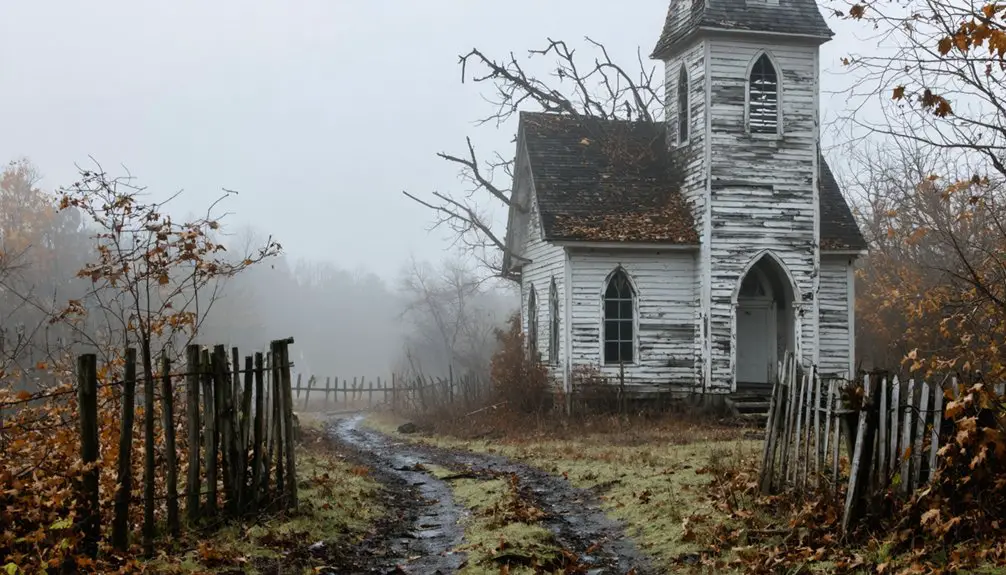You’ll find Chestonia’s remains in northern Michigan, where Thomas R. Van Wert established this lumber settlement in 1874. The town flourished through the 1890s thanks to the East Jordan Lumber Company’s operations and the Detroit, Bay City and Alpena Railroad connection. After aggressive clear-cutting depleted local timber, Chestonia gradually declined until its post office closed in the 1960s. Today, no original buildings stand, but the town’s story captures Michigan’s dramatic lumber boom-and-bust era.
Key Takeaways
- Chestonia, established in 1874 by Thomas R. Van Wert, flourished as a lumber town before becoming a ghost town in Michigan.
- The community’s decline began when aggressive clear-cutting depleted local timber supplies by the late 1800s.
- East Jordan Lumber Company’s closure and reduced railway service from Detroit and Charlevoix accelerated the town’s abandonment.
- The post office’s shutdown in the 1960s marked a final blow, leading to widespread resident relocation.
- Today, no original buildings remain from Chestonia’s settlement period, with the former commercial district completely erased.
The Birth of a Lumber Town
When Thomas R. Van Wert arrived in 1874, he couldn’t have known he was laying the foundation for Michigan’s next lumber boomtown. His settlement sparked the official organization of Chestonia Township that same year, marking the beginning of a brief but significant chapter in local lumber history.
You’ll find the town’s early development closely tied to the East Jordan Lumber Company, which owned most of the surrounding land. The rich stands of white pine drew their attention, and by 1876, the establishment of the Chestonia post office signaled growing community dynamics. Like other lumber towns of the era, Chestonia faced the constant risk of sawmill fires that could devastate operations. The town’s location at M-66 and E. Old State Road intersection proved strategic for regional commerce.
The company town quickly took shape, with a railway depot, general store, and worker housing built by skilled craftsmen. Natural waterways and purpose-built roads supported the logging operations, creating a bustling hub of timber extraction in Michigan’s northern pine belt.
Railway Development and Economic Growth
As the Detroit, Bay City and Alpena Railroad extended its reach through northern Michigan in the 1890s, Chestonia emerged as a significant hub in the region’s expanding rail network.
Railway innovation transformed this remote settlement into a thriving center of commerce, where economic integration with major markets in Chicago and Detroit fueled unprecedented growth.
The Michigan Central corporation took ownership of key rail lines in 1846, helping establish critical transportation infrastructure throughout the state. The addition of surplus rail cars from the 1893 Chicago World’s Fair provided essential equipment for the region’s growing transportation needs.
- Michigan Central Railroad’s expansion provided essential interstate transportation corridors
- Rail access enabled year-round lumber operations, especially during harsh winters
- Strategic placement of repair shops and terminals supported reliable freight movement
- Railway employment offered stable wages, attracting a skilled workforce
- New commercial enterprises, from general stores to equipment suppliers, flourished along the rail lines
You’ll find that the railroad’s influence reached far beyond transportation, shaping everything from property values to population patterns in this once-bustling lumber town.
Daily Life in Early Chestonia
The rhythms of daily life in Chestonia took shape around Thomas R. Van Wert’s 1874 settlement, where you’d find residents scattered across modest wooden homes near the central area.
Nestled in Michigan’s woodlands, Chestonia grew from Van Wert’s vision into a close-knit community of timber-frame homes and pioneering spirits.
Your daily routines would’ve revolved around the East Jordan Lumber Company‘s operations, with the general store serving as your hub for community interactions and essential supplies.
You’d rely on the railway depot for connections to the outside world, while the post office kept you linked to distant family and friends.
Life wasn’t densely urban – you’d find yourself in a rural setting where your livelihood depended on the lumber industry’s success.
The absence of railroad access eventually contributed to the town’s economic struggles, similar to what happened in Rawsonville.
When you needed supplies, you’d head to the general store, which doubled as a gathering spot where you’d catch up with neighbors and share news about the community.
Much like the town of Singapore, Chestonia’s fate was sealed when deforestation and erosion gradually destroyed the community’s economic foundation.
Rise and Fall of the Timber Industry
At its peak in the mid-1800s, you’d have found Chestonia’s mills producing tens of thousands of board feet daily, employing scores of workers who operated the steam-powered saws and machinery. Many early timber companies from New York firms established large operations in the area, acquiring substantial tracts of forested land.
You could track the town’s prosperity through the 1870s and 1880s as the lumber yards bustled with activity, processing the seemingly endless supply of white pine from surrounding forests.
The good times wouldn’t last, though, as aggressive harvesting depleted the local timber supply by the late 1800s, forcing mills to close and workers to seek opportunities elsewhere.
Booming Lumber Production Years
During Michigan’s mid-1800s lumber boom, eastern techniques and capital transformed the Saginaw Valley into a powerhouse of timber production.
You’d find lumber techniques evolving rapidly as logging practices adapted to Michigan’s vast white pine forests, estimated at over 150 billion board feet. Similar to New England’s early timber harvests, Michigan’s operations relied on abundant old growth for sustained production.
The industry’s explosive growth brought these remarkable developments:
- Saginaw Valley’s annual lumber earnings skyrocketed from $1 million to $7 million by 1869
- Winter logging operations utilized snow-covered ground for efficient log transport
- Innovative “booming” practices used spring waters to float logs downstream
- Log marks stamped on timber enabled ownership identification at sorting areas
- Rivers flowing to Saginaw Bay and Muskegon became essential transport routes
Michigan dominated U.S. lumber production for three decades, with output doubling as mills expanded and companies pushed deeper into the peninsula’s interior forests. Lumberjacks from Ireland, Sweden, and various American states brought their diverse cultural backgrounds to the camps.
Mill Operations and Employment
While Michigan’s lumber industry boomed throughout the late 1800s, Chestonia’s mills emerged as essential economic engines, processing the region’s abundant white pine through a complex network of water-powered operations.
You’d find “shanty boys” and immigrant workers manning the saws, with lumber mill operations running seasonally as timber flowed downriver to the facilities.
The workforce dynamics shifted as technology evolved from water wheels to steam power. You could see the transformation in the mills, where skilled machinists gradually replaced some of the manual laborers. By the peak year of 1889, Michigan’s lumber production reached an astounding 5.5 billion board feet.
While the work remained physically demanding, these mills created tight-knit communities where workers shared housing and meals.
As timber resources dwindled, though, the mills began to close, and workers moved on, leaving behind the remnants of Chestonia’s once-thriving lumber economy.
Resource Depletion Effects
Once Michigan’s virgin forests beckoned lumber companies with seemingly endless supplies of white pine, the true scope of resource depletion would soon become apparent.
By 1900, you’d have witnessed the devastating transformation of Michigan’s landscape through aggressive clear-cutting that left countless towns, including Chestonia, facing economic collapse.
- Over 160 billion board feet of timber harvested by 1897, primarily targeting valuable white pine
- Clear-cutting practices led to widespread soil erosion and wildlife habitat destruction
- Local economies crashed when timber resources were exhausted
- Ghost towns emerged as logging operations abandoned depleted areas
- Lack of sustainable forestry practices delayed ecological restoration for decades
Today’s forest management practices stand in stark contrast to the unchecked exploitation of Michigan’s timber resources, serving as a powerful reminder of how unrestricted resource extraction can devastate both environment and economy.
The Final Years of Operation
As timber resources around Chestonia dwindled in the early 20th century, the East Jordan Lumber Company’s operations steadily declined, triggering the town’s eventual demise.
You’d have witnessed the community decline accelerate as the Detroit and Charlevoix railway reduced its service, cutting off essential transportation links that had once connected the village to larger markets.
The most visible signs of service loss came when local businesses started closing their doors, culminating in the post office’s shutdown in the 1960s.
Without employment opportunities or basic amenities, residents had little choice but to seek opportunities elsewhere.
What Remains Today

Today’s visitor to Chestonia will find little evidence of the once-thriving lumber town. Located at the junction of M-66 and E. Old State Road in Jordan Township, the site offers no remnant infrastructure from its heyday.
While community memory preserves Chestonia’s story through historical records, the physical landscape reveals only scattered modern houses and regrown woodland where the East Jordan Lumber Company once operated.
- No original buildings remain standing from the settlement period
- The post office, which closed in the 1960s, has completely vanished
- Former commercial district shows no trace of stores or businesses
- Rail lines and timber lands have transformed into natural settings
- Historical artifacts exist only in private collections and local museums
Legacy in Michigan’s Ghost Town History
When you explore Michigan’s ghost towns, you’ll find Chestonia’s story mirrors dozens of similar communities that sprung up during the lumber boom and vanished as resources depleted.
Michigan’s landscape is dotted with these abandoned settlements, from copper mining towns in the Upper Peninsula to logging camps in the Lower Peninsula, all sharing Chestonia’s familiar pattern of rapid growth and decline.
You can trace parallel histories through towns like Fayette, Delaware, and Pere Cheney, where economic dependence on single industries led to their eventual abandonment, leaving behind valuable lessons about sustainable community development.
Historical Parallels and Patterns
Throughout Michigan’s history, ghost towns have followed distinct patterns of rise and decline that mirror broader economic and social trends across the state.
You’ll find these economic cycles reflected in communities that once thrived on natural resources, only to face abandonment when those resources depleted. Demographic shifts often followed predictable patterns, particularly in the Upper Peninsula’s mining regions.
- Resource-dependent towns faced swift population booms followed by dramatic busts
- Health crises and harsh living conditions accelerated town abandonments
- Single-industry economies proved vulnerable to collapse
- Immigrant settlements struggled against frontier challenges
- Transportation changes made some communities obsolete
These recurring patterns shaped Michigan’s landscape of ghost towns, where you can still witness the remnants of boom-and-bust cycles that transformed thriving communities into abandoned settlements.
Preserving Abandoned Town Stories
Michigan’s ghost town stories provide essential windows into the state’s rich heritage, demanding thoughtful preservation efforts to maintain these irreplaceable historical resources.
You’ll find various storytelling strategies being employed across the state, from digital archives to interpretive sites, ensuring these abandoned communities’ tales don’t fade into obscurity.
Through community engagement initiatives, local historical societies partner with state agencies to document oral histories, stabilize remaining structures, and create educational programs.
The Keweenaw Time Traveler app exemplifies modern preservation tools, allowing you to explore Michigan’s ghost towns virtually.
While challenges like vandalism and funding limitations persist, preservation projects continue through the State Historic Preservation Office’s support and recognition.
These efforts help you connect with Michigan’s economic and social history while safeguarding architectural remnants and personal narratives for future generations.
Frequently Asked Questions
What Was the Population of Chestonia at Its Peak?
You’ll find the town demographics never exceeded 500 residents at its peak, though precise historical significance is uncertain since no official census data exists for this small lumber-based community.
Were There Any Schools or Churches Established in Chestonia?
You won’t find any documented school history or church community establishments here. Based on historical records, residents likely relied on nearby towns for these services during Chestonia’s brief industrial period.
What Happened to the Families Who Lived There After Abandonment?
Like leaves scattered by autumn winds, family legacies dispersed as you’d expect – parents sought lumber jobs elsewhere, while community migration patterns led folks toward Michigan’s industrial centers and Midwest opportunities.
Did Any Major Accidents or Disasters Occur in Chestonia’s History?
You won’t find any records of fatal incidents or historical fires there. The town’s decline came purely from economic factors, mainly when timber resources were depleted, not from any catastrophic events.
Are There Any Surviving Photographs of the Original Town Buildings?
Time has erased what once stood tall – you won’t find any surviving photographs of the original buildings in historical documentation. The architectural remnants have vanished completely, leaving only written accounts behind.
References
- https://99wfmk.com/chestonia-michigan/
- https://mymagicgr.com/ghost-towns-michigan/
- https://www.youtube.com/watch?v=7-vjuqiGWJU
- https://michiganhomeandlifestyle.com/the-towns-that-once-were-michigans-ghost-towns/
- https://www.smithsonianmag.com/history/once-a-year-this-19th-century-michigan-ghost-town-comes-to-life-180982695/
- https://www.youtube.com/watch?v=d_vMU5E1JpI
- https://msaf.forest.mtu.edu/ForestInfo/MSUElibrary/LumberingInMichigan.PDF
- https://thegame730am.com/lumber-camps/
- https://www.ourmidland.com/news/article/Former-lumber-town-full-of-history-7125114.php
- https://en.wikipedia.org/wiki/Michigan_Central_Railroad


